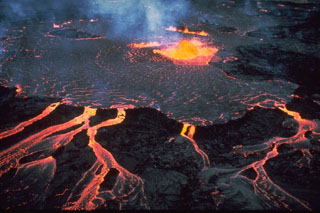Report on Kilauea (United States) — 19 March-25 March 2025
Smithsonian Institution / US Geological Survey
Weekly Volcanic Activity Report, 19 March-25 March 2025
Managing Editor: Sally Sennert.
Please cite this report as:
Global Volcanism Program, 2025. Report on Kilauea (United States) (Sennert, S, ed.). Weekly Volcanic Activity Report, 19 March-25 March 2025. Smithsonian Institution and US Geological Survey.
Kilauea
United States
19.421°N, 155.287°W; summit elev. 1222 m
All times are local (unless otherwise noted)
The Hawaiian Volcano Observatory (HVO) reported that the eruption within Kilauea’s Kaluapele summit caldera, from vents along the SW margin of Halema’uma’u Crater, continued at variable levels during 18-25 March. Occasional bursts of spatter rose from the N vent overnight during 18-19 March, with activity becoming more frequent in the morning. From 2358 on 18 March to 0514 on 19 March the S vent overflowed six times, sending lava flows up to 50 m across the crater floor. During 0602-0610 lava overflowed the S vent for a seventh time and was accompanied by large spatter bursts that could be seen over the top of the N vent cone in a webcam. None of the lava flows were active for more than 10 minutes. Spatter activity at both vents waned around 0700 and then increased at around 0920. Lava overflowed the N vent at 0926 and the S vent during 0950-1035. At the N vent periods of low domed fountains, as high as 10 m, alternated with “drainbacks” (2-3 m drops) of the 65 x 45 m lava pond that occurred every 5-10 minutes, with the interval decreasing over time.
The dome fountains significantly increased in size at around 0200 on 20 March, rising 15-30 m. Fountains rose from the S vent at 0630, and within 20 minutes both vents were producing sustained fountains. By 0715 the fountains were rising 120-180 m and lava covered more than half the crater floor. Fountaining at the N vent ceased at 0746 while fountain heights at the S vent increased to 200 m. Fountaining at the S vent continued through the early afternoon, rising as high as 180 m. All activity ceased by 1349 and lava flows covered about three quarters of the crater floor. A maximum sulfur dioxide gas emission rate was approximately 50,000 tons per day (t/d) during the morning of 20 March. The rate had decreased to 1,500 t/d by 1700. The fountains produced tephra such as pumice and Pele's Hair; Pele’s Hair was reported on surfaces in areas within Hawai’i Volcanoes National Park and surrounding communities. Spots of orange glow on the crater floor were visible at night as the erupted lava cooled. The vents degassed and were incandescent at night during 21-24 March. Activity at the vents resumed on 25 March. Eight cycles of small spatter fountaining at the N vent began at 0927, 0955, 1011, 1029, 1048, 1107, 1127, and 1145, with each cycle lasting 5-10 minutes. The ninth cycle occurred during 1204-1219 and produced lava flows that extended 50-100 m across the crater floor. Activity that began at the S vent around noon also sent lava flows onto the crater floor. Cyclic fountaining, 10-15 m high, at the N vent was visible during 1225-1239, 1247-1302, 1308-1323, 1329-1339, and 1346-1358. Lava covered about 5 percent of the crater floor by around 1400. The Volcano Alert Level remained at Watch (the third level on a four-level scale) and the Aviation Color Code remained at Orange (the third color on a four-color scale).
Geological Summary. Kilauea overlaps the E flank of the massive Mauna Loa shield volcano in the island of Hawaii. Eruptions are prominent in Polynesian legends; written documentation since 1820 records frequent summit and flank lava flow eruptions interspersed with periods of long-term lava lake activity at Halemaumau crater in the summit caldera until 1924. The 3 x 5 km caldera was formed in several stages about 1,500 years ago and during the 18th century; eruptions have also originated from the lengthy East and Southwest rift zones, which extend to the ocean in both directions. About 90% of the surface of the basaltic shield volcano is formed of lava flows less than about 1,100 years old; 70% of the surface is younger than 600 years. The long-term eruption from the East rift zone between 1983 and 2018 produced lava flows covering more than 100 km2, destroyed hundreds of houses, and added new coastline.
Source: US Geological Survey Hawaiian Volcano Observatory (HVO)

